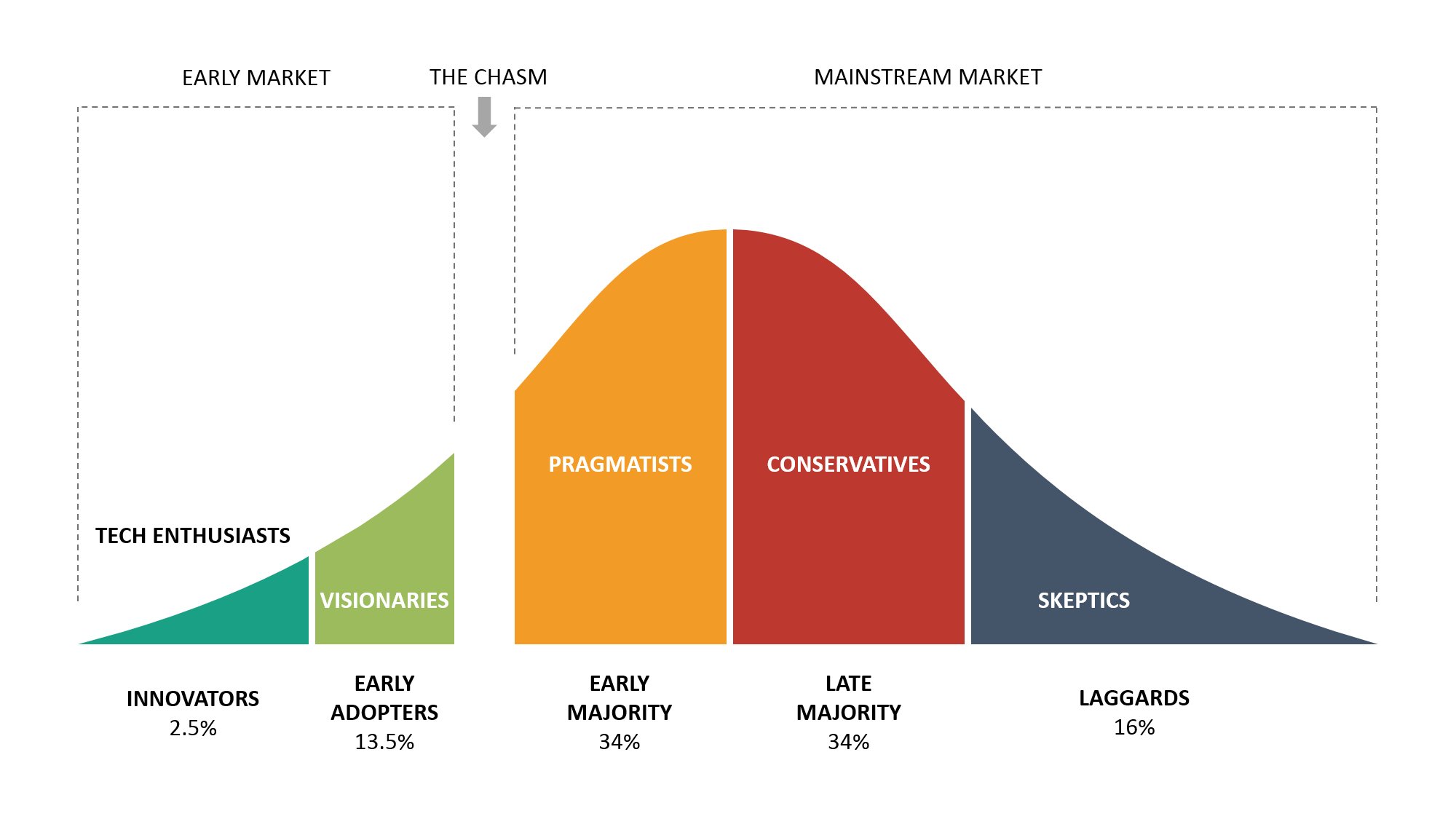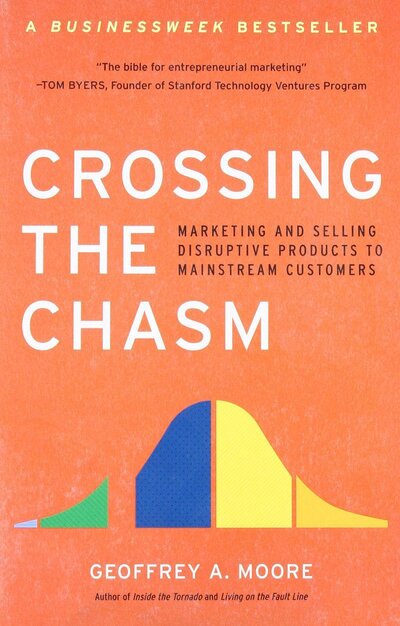In Crossing the Chasm: Marketing and Selling High-Tech Products to Mainstream Customers, 1 American organizational theorist and management consultant, Geoffrey Moore describes through the Technology Adoption Life Cycle (innovators - early adopters - the early majority - the late majority - laggards) that there is a chasm between the early adopters and the early majority. The book focuses on understanding the technology adoption lifecycle, marketing high-tech products during the early startup period, and strategies for crossing the chasm.
Crossing the Chasm is based on understanding the Technology Adoption Lifecycle, a model for understanding the acceptance of new products. The model describes the market penetration of any new technology product in terms of a progression in the types of consumers it attracts throughout its useful life.
The model is divided into five psychographic profiles of consumers.
- The Laggard (Late Adopter of Technology) - “Not until hell freezes over”.
- The early majority (Middle of the road adopter) - “When I have seen electric cars prove themselves and when there are enough service stations on the road”.
- The Late Majority (Follower) - “Not until most people have made the switch and it becomes really inconvenient to drive a gasoline car”.
- The Early Adopter and Innovator - “You want to be the first one on your block with an electric car”
The groups are distinguished from each other by their characteristic response to a discontinuous innovation based on a new technology. Each group represents a unique psychographic profile—a combination of psychology and demographics that makes its marketing responses different from those of the other groups. Understanding each profile and its relationship to its neighbors provides a critical foundation for high-tech marketing overall.

The Five Psychographic Profiles of the Technology Adoption Lifecyle
Innovators
Innovators pursue new technology products aggressively. They sometimes seek them out even before a formal marketing program has been launched. This is because technology is a central interest in their life, regardless of what function it is performing.
Early adopters
Early adopters like innovators, buy into new product concepts very early in their life cycle, but unlike innovators, they are not technologists. Rather they are people who find it easy to imagine, understand, and appreciate the benefits of a new technology, and to relate these potential benefits to their other concerns.
Whenever they find a strong match, early adopters are willing to base their buying decisions upon it. Because early adopters do not rely on well-established references in making these buying decisions, preferring instead to rely on their own intuition and vision, they are core to opening up any high-tech market segment.
Early Majority
The early majority share some of the early adopter’s ability to relate to technology, but ultimately they are driven by a strong sense of practicality. They know that many of these newfangled inventions end up as passing fads, so they are content to wait and see how other people are making out before they buy in themselves.
They want to see well-established references before investing substantially. Because there are so many people in this segment—roughly one-third of the whole adoption life cycle—winning their business is fundamental to any substantial profits and growth.
Late Majority
The late majority shares all the concerns of the early majority, plus one major additional one: Whereas people in the early majority are comfortable with their ability to handle a technology product, should they finally decide to purchase it, members of the late majority are not. As a result, they wait until something has become an established standard, and even then they want to see lots of support and tend to buy, therefore, from large, well-established companies.
“Like the early majority, this group comprises about one-third of the total buying population in any given segment.”
Laggards
These people simply don’t want anything to do with new technology, for any of a variety of reasons, some personal and some economic. The only time they ever buy a technological product is when it is buried deep inside another product—the way, say, that a microprocessor is designed into the braking system of a new car—such that they don’t even know it is there.
“From a market development perspective laggards are generally regarded as not worth pursuing on any other basis.”
“The farther right you go on the curve, the more you will encounter the clients and customers who may need what you have, but don’t necessarily believe what you believe. As clients, they are the ones for whom, no matter how hard you work, it’s never enough. Everything usually boils down to price with them. They are rarely loyal.
“They rarely give referrals and sometimes you may even wonder out loud why you still do business with them. “They just don’t get it,” our gut tells us. The importance of identifying this group is so that you can avoid doing business with them. Why invest good money and energy to go after people who, at the end of the day, will do business with you anyway if you meet their practical requirements but will never be loyal if you don’t? It’s not too hard to recognize where people fall on the spectrum once you’re in a relationship with them; the opportunity is to figure out which is which before you decide to work with them.”
“We all sit at different places on this spectrum depending on the product or idea. Most of us are fiercely loyal to certain products and ideas at various times and demonstrate left-side-of-the-curve behavior. And for other products or ideas we exhibit right-side-of-the-curve behavior. When we sit on one side of the spectrum, we often have a hard time understanding those on the other side because their behavior doesn’t make sense to us.” 2
“Each of us assigns different values to different things and our behaviors follow accordingly. This is one of the major reasons why it is nearly impossible to “convince” someone of the value of your products or ideas based on rational arguments and tangible benefits.” - Simon Sinek, Start With Why
Understanding the technology adoption lifecycle is very important especially when you are developing the customer journey profile for your products and services.
Looking to build your successful tech Startup? Join our 12-week cohort of tech startups for Black founders by Black industry experts.
